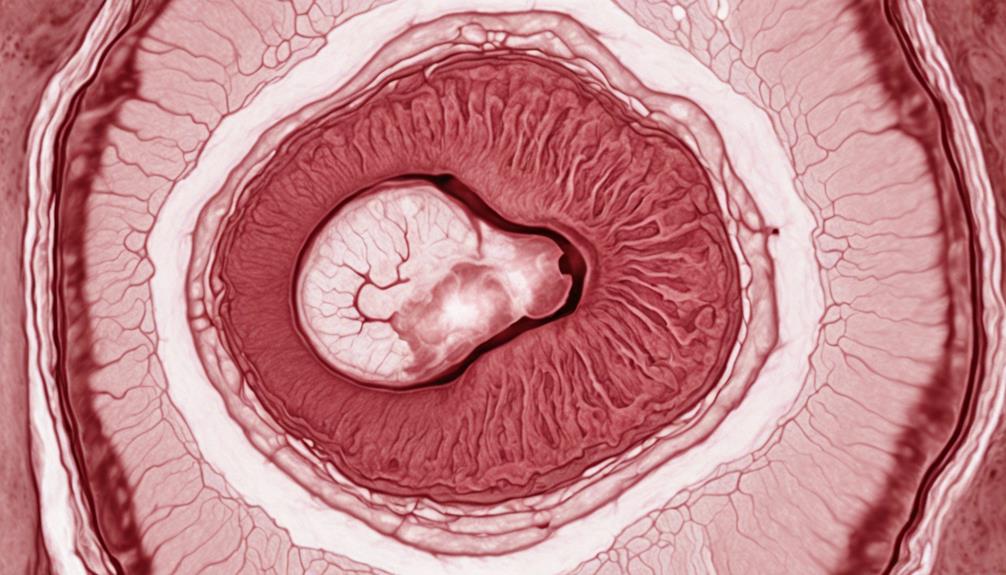Investigating the underlying reasons for miscarriages in the second trimester can feel like trying to navigate a complex maze of biological intricacies.
From placental abnormalities to maternal health conditions, various factors intertwine to influence the delicate balance of pregnancy during this critical period.
Understanding these intricate connections is not just a matter of curiosity; it holds the key to unraveling the mysteries behind why some pregnancies face unexpected challenges.
Let's explore the intricate web of factors that contribute to second-trimester miscarriages and shed light on the importance of holistic care in such situations.
Key Takeaways
- Maternal health conditions like diabetes and infections increase the risk of second-trimester miscarriage.
- Placental abnormalities, such as defective attachment and histological issues, are significant factors in mid-trimester pregnancy loss.
- Uterine problems like anomalies and cervical weakness can disrupt normal pregnancy progression, leading to miscarriage.
- Genetic factors, including inherited conditions and fetal abnormalities, play a crucial role in the occurrence of second-trimester miscarriages.
Maternal Health Conditions
Maternal health conditions, such as diabetes, high blood pressure, thyroid disorders, and autoimmune diseases, greatly heighten the likelihood of experiencing a second trimester miscarriage. These chronic illnesses, like lupus, kidney disease, and heart conditions, can also play a role in the occurrence of miscarriages during this period. Infections, such as urinary tract infections, sexually transmitted infections, and bacterial vaginosis, further increase the risk of second trimester pregnancy loss. When these conditions aren't properly managed, they can impact both the fetus's development and the health of the placenta, potentially leading to a miscarriage.
It is important to control and manage maternal health conditions effectively before and during pregnancy to reduce the chances of a second trimester miscarriage. Regular monitoring and early intervention are essential in ensuring that these conditions don't escalate and pose a threat to the pregnancy. By addressing these health concerns proactively, the risk of experiencing a second trimester miscarriage can be mitigated.
Placental Abnormalities

Placental abnormalities, such as placental abruption or maternal vascular malperfusion, are significant factors contributing to second trimester miscarriage occurrences. Defective haemochorial placentation, where the placenta improperly attaches to the uterine wall, is a common cause of mid-trimester miscarriages. Placental histological abnormalities, like acute chorioamnionitis, are frequently observed in second trimester miscarriages. Specific placental pathology, such as placental inflammation, can contribute to the etiology of spontaneous mid-trimester miscarriages. Understanding placental histology in second trimester miscarriages is important for identifying risks in future pregnancies and guiding management strategies.
| Placental Abnormalities | Examples |
|---|---|
| Defective haemochorial placentation | Improper placental attachment to uterine wall |
| Placental histological abnormalities | Acute chorioamnionitis |
| Specific placental pathology | Placental inflammation |
Uterine Issues
Uterine issues, including Müllerian anomalies or uterine leiomyomas, can disrupt normal pregnancy progression and contribute to second trimester miscarriage. Cervical insufficiency, a condition where the cervix is weak and unable to support the growing fetus, is commonly linked to second trimester miscarriage.
These uterine abnormalities can impact vital processes like implantation, placental development, and fetal growth, heightening the risk of miscarriage during the second trimester. To mitigate this risk, it's essential to identify and address uterine issues through diagnostic tests and appropriate treatment.
Surgical interventions may be necessary to correct these abnormalities, improving the chances of a successful pregnancy for individuals at risk of second trimester miscarriage. By understanding and managing uterine issues effectively, individuals can enhance their reproductive outcomes and reduce the likelihood of experiencing a miscarriage in the second trimester.
Infections and Illnesses

Infections and illnesses play a significant role in increasing the risk of second trimester miscarriage. Certain pathogens and maternal health conditions pose particular threats to pregnancy viability. Untreated infections such as parvovirus, cytomegalovirus (CMV), listeria, and toxoplasmosis can heighten the likelihood of second trimester miscarriage. Maternal health conditions like diabetes, hypertension, and thyroid disorders are also known risk factors for pregnancy loss during this period.
Complications arising from infections that impact the placenta or fetal development, such as rubella or syphilis, can further elevate the risks of second trimester miscarriages.
Prompt diagnosis and timely treatment of infections and illnesses are important in mitigating the chances of second trimester miscarriage. Without proper intervention, these conditions can lead to serious consequences for both the mother and the developing fetus.
Close monitoring and management of infections, along with maintaining maternal health, are essential to safeguarding the pregnancy and reducing the risks associated with second trimester miscarriage.
Genetic Factors
Genetic factors play an important role in the occurrence of second trimester miscarriages, playing an essential role in the pregnancy's viability and outcome. Inherited genetic conditions like Factor V Leiden mutation or prothrombin gene mutation can increase the risk of late miscarriages.
Mutations in genes related to blood clotting disorders can lead to complications in pregnancy and contribute to second trimester losses. Abnormalities in the genetic makeup of the developing fetus can result in structural or developmental issues, leading to miscarriage in the second trimester.
Genetic testing of the fetus and parents can help identify potential genetic factors contributing to second trimester miscarriages and guide future reproductive decisions. Understanding these genetic factors is critical in managing the risk of second trimester miscarriages and making informed decisions regarding prenatal care and family planning.
Frequently Asked Questions
What Are the Common Causes of Miscarriage in Second Trimester?
We'll explore common causes of second trimester miscarriage. Chromosomal abnormalities, uterine structural issues, cervical insufficiency, thrombophilic disorders, and infections like bacterial vaginosis can all contribute to pregnancy loss during this stage.
How Can I Prevent a Miscarriage in the Second Trimester?
We can prevent a second trimester miscarriage by maintaining a healthy lifestyle, seeking regular prenatal care, managing chronic health conditions, screening for infections, detecting and managing cervical or uterine issues early, and considering genetic counseling for personalized preventive measures.
Are Second Pregnancy Miscarriages Common?
Second trimester miscarriages, occurring in about 1-5% of pregnancies, are less common than first trimester losses. They involve various causes like chromosomal abnormalities, infections, and maternal health conditions. Timely medical care is crucial for addressing underlying issues and preventing complications.
What Happens at 12 Weeks of Miscarriage?
At 12 weeks of miscarriage, we may experience heavy bleeding, severe cramping, and passing tissue. Medical intervention could be necessary to prevent complications and make sure proper management. Support from healthcare providers is essential during this challenging time.
Conclusion
To sum up, second-trimester miscarriages are often caused by a complex interplay of maternal health conditions, placental abnormalities, uterine issues, infections, and genetic factors.
Just as a delicate symphony requires each instrument to play its part flawlessly, a healthy pregnancy necessitates harmony among various factors.
By understanding and addressing these underlying causes, healthcare providers can better support individuals facing the challenge of second-trimester miscarriages, offering hope for future pregnancies.










